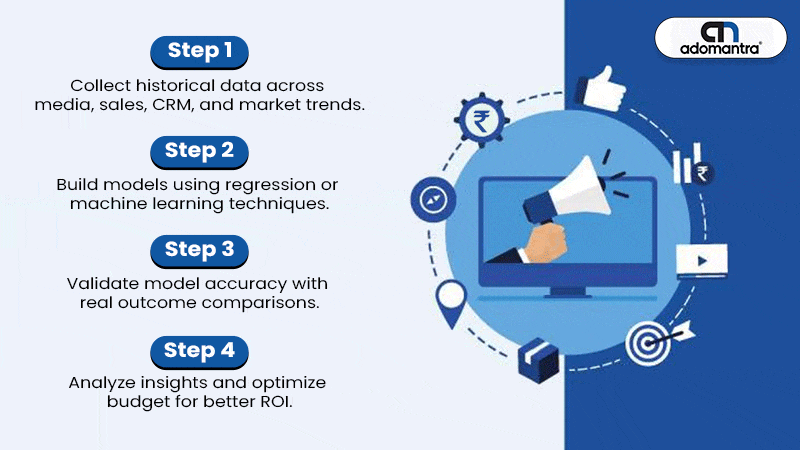
Guide to Marketing Mix Modeling and Best Practices
What if you could predict the return on every dollar you spend across all marketing channels?
For B2B marketers, where the sales cycle is long and decisions involve multiple stakeholders, measuring true marketing effectiveness is tough. Standard attribution models often miss the mark. You need a strategy that provides a holistic, data-driven view of performance. That is where Marketing Mix Modeling (MMM) comes in.
In this guide, we break down what Marketing Mix Modeling really means, how it works, and why B2B businesses must adopt it now. With real-world insights, best practices, and expert-backed advice, this article is designed to help you make confident, strategic decisions backed by data.
What is Marketing Mix Modeling and Why Does it Matter?
Marketing Mix Modeling is a statistical analysis technique that quantifies the impact of different marketing activities like media, promotions, pricing, and external factors on key business outcomes like revenue, leads, or conversions.
For B2B brands, this goes beyond just ad performance. It helps you understand how trade shows, webinars, content, email, and digital ads all work together to influence buyer behavior.
Key Benefits of Marketing Mix Modeling
- Holistic performance insight – See how offline and online tactics combine to drive growth
- Channel optimization – Reallocate budgets based on contribution to sales, not just clicks
- Scenario planning – Forecast the outcome of increasing or decreasing spend in a specific channel
- Data-backed decisions – Reduce waste and build a strategy based on results, not assumptions
Companies using advanced analytics like MMM improve their marketing ROI by up to 30%.
The Marketing Mix Modeling Process Explained
Here is how a complete Marketing Mix Modeling framework is typically structured for B2B marketers:

Step 1: Data Collection
Gather structured historical data across multiple categories:
- Paid media spend by channel
- Sales or lead data (daily, weekly, or monthly)
- CRM data including lead source, conversion time, lifecycle stage
- External data like seasonality, competitor activity, economic trends
Pro tip: Include both lagging and leading indicators (like impressions, page views, and brand mentions) for a more accurate model.
Step 2: Model Development
Use multivariate regression models or machine learning algorithms to identify patterns. The model isolates the impact of each factor by controlling for all others.
Step 3: Calibration and Validation
Validate your model with out-of-sample testing or compare predictions against actual results to ensure reliability.
Step 4: Insights and Optimization
Understand which marketing levers contribute the most to sales. Reallocate spend to high-performing areas. Test different “what-if” scenarios to guide future strategy.
Real-World B2B Use Case
Let us say a B2B cybersecurity firm spends across these channels:
- Google Ads
- LinkedIn campaigns
- Content syndication
- Webinars
- Email nurturing
Using MMM, they find:
- LinkedIn accounts for 40% of MQLs, but only 18% of spend
- Webinars influence deals worth 2x more than other leads
- Content syndication drives top-of-funnel awareness but low conversion
With this insight, they shift 20% of Google Ads spend to webinars and LinkedIn, improving cost per acquisition by 22% in the next quarter.
Best Practices for B2B Marketing Mix Modeling
1. Ensure Data Consistency Across Systems
Unify data sources. A fragmented CRM, media buying tool, and analytics platform will break your model before it starts. Standardize naming, timeframes, and formats.
2. Account for Sales Cycle Lag
Unlike B2C, B2B conversions take weeks or months. Make sure your model includes time-lag effects to measure long-term outcomes from earlier marketing efforts.
3. Include Non-Marketing Variables
Control for external factors like competitor launches, industry seasonality, or macroeconomic shifts. This ensures marketing gets credit only for what it truly influences.
4. Segment by Buyer Persona or Product
A VP of IT might respond differently than a procurement manager. Build multiple models if necessary to reflect real buyer behavior.
5. Combine MMM with Real-Time Attribution
Marketing Mix Modeling works best when paired with short-term attribution models like Multi-Touch Attribution (MTA). MMM gives the strategic view, while MTA provides real-time feedback.
Key Advanced Strategies
Embrace Predictive Modeling with AI
Modern MMM models now integrate machine learning and AI to improve prediction accuracy. By using AI, you can test hundreds of budget reallocation scenarios and instantly forecast outcomes.
Businesses using AI-powered marketing analytics outperform competitors by 15% in sales growth.
Use MMM to Drive Boardroom Decisions
B2B CMOs can use MMM outputs to justify budget increases, influence GTM planning, or defend underperforming channels with supporting data. It is more than marketing, it is strategy.
Align MMM with Revenue Operations
MMM works best when marketing, sales, and finance align on success metrics. Define shared goals like revenue contribution, pipeline velocity, and deal size to drive unified action.
Where Most B2B Brands Go Wrong
- Relying only on digital attribution for long-cycle sales
- Not refreshing the model regularly
- Ignoring offline activities like trade shows or partner marketing
- Oversimplifying results without context
Avoid these pitfalls by maintaining a feedback loop with your sales and finance teams and continuously validating model outputs with real performance data.
Conclusion
Marketing Mix Modeling helps B2B businesses shift from guesswork to growth. It unlocks insights hidden across fragmented channels and helps you make smarter decisions with confidence.
Want to build a smarter, more profitable marketing engine? Connect with our team to explore a custom Marketing Mix Modeling strategy for your business.
Frequently Asked Questions
Q1. How long does it take to implement Marketing Mix Modeling?
A1. It depends on data availability and complexity, but most models can be built within 6 to 10 weeks with the right internal and external teams.
Q2. Can MMM be used for account-based marketing (ABM)?
A2. Yes. By analyzing ABM campaigns separately, you can measure their ROI and compare them to other lead gen tactics.
Q3. How often should MMM models be updated?
A3. Quarterly updates are ideal for fast-moving markets. Semi-annual refreshes work for stable industries with long sales cycles.
Q4. Does MMM replace digital attribution tools?
A4. No. It complements them. Use both to get a complete view of long-term and short-term marketing effectiveness.







